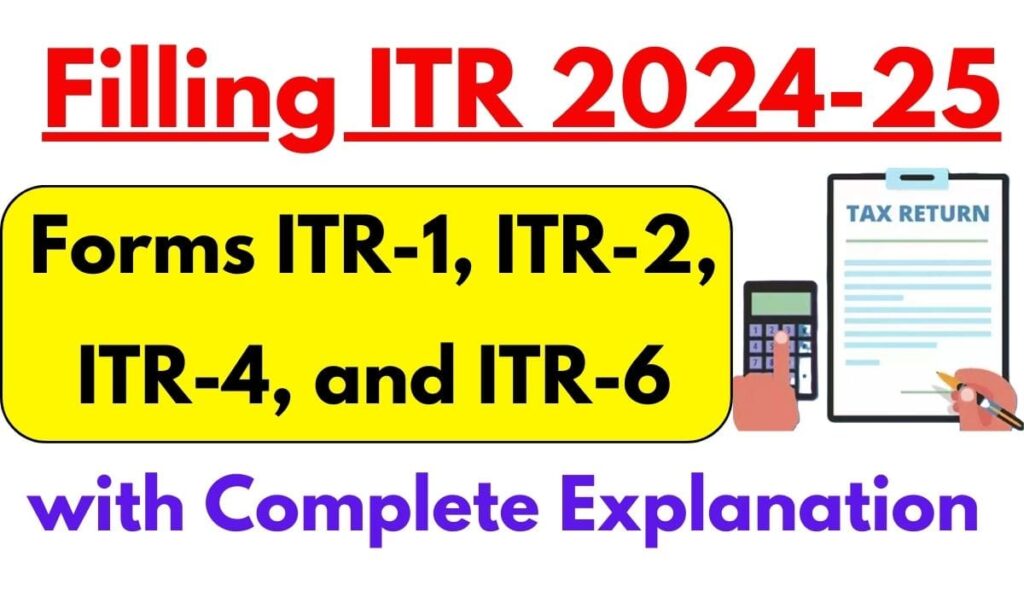Filling Income Tax Return 2024-25: Planning to file your income tax return for the financial year 2024-25? It’s essential to know which form suits your needs. The Income Tax Department (ITD) has released various forms, including ITR-1, ITR-2, ITR-4, and ITR-6, for e-filing on their portal. Understanding which form to use is crucial to ensure accurate filing and compliance with tax regulations. Let’s delve into the details to help you make the right choice for your tax filing.
Filing your income tax return (ITR) is very important for managing your money. If you don’t do it right, you might get into trouble with the law. So, it’s really important to know how to file your ITR and the steps you need to follow. One crucial step is picking the right ITR form. The Income Tax Department (ITD) provides all the forms you need for e-filing on their website. These forms include ITR-1, ITR-2, ITR-4, and ITR-6. Let’s dive into understanding these forms and the process of filing your ITR 2024-25 correctly.
Income Tax Return Forms ITR-1, ITR-2, ITR-4, and ITR-6
Income Tax Return (ITR) forms such as ITR-1, ITR-2, ITR-4, and ITR-6 are now ready for e-filing. Recently, the Income Tax department has made available the excel utility of ITR-6 for the Assessment Year 2024-25. This means taxpayers can now use this form to file their income tax returns electronically.
Important Dates to Fill The ITR 2024-25
It’s important to note that the last date to file your Income Tax Return for the financial year 2023-24 is August 31, 2024. According to a report from the news agency PTI, the All-India Federation of Tax Practitioners (AIFTP) has formally requested the Central Board of Direct Taxes (CBDT) to extend the deadline for filing income tax returns for the assessment year 2024-25 to August 31.
This deadline is crucial, and taxpayers are advised to complete their filing before this date to avoid any penalties or late fees. Make sure to gather all the necessary documents and information required for filing your ITR to avoid any last-minute rush.
| Last date to fill income tax return 2024 | August 31 |
Let’s Understand ITR Forms in Details
ITR-1 FORM:
The ITR-1 form is for people who live in India (except those who aren’t usually residents) and have a total income of up to Rs 50 lakh. It includes earnings from jobs, one house they own, other income (such as interest), and agricultural income up to Rs 5,000.
Who can’t use ITR-1 form
- High Earners: If your total income for the year is more than Rs. 50 lakh, ITR-1 is not for you.
- Multiple Property Owners: If you’re lucky enough to own more than one house or property that you rent out, you can’t use ITR-1.
- Foreign Asset Owners: If you have financial assets or bank accounts outside India, ITR-1 won’t have the right sections to report them.
ITR-2 FORM:
The ITR-2 form is actually for individuals and Hindu Undivided Families (HUFs) who earn income from various sources, but NOT from business or profession carried on by them.
Who can use ITR-2:
- People and HUFs with income from sources like interest on investments, capital gains, rental income from multiple properties, foreign income, etc.
Who cannot use ITR-2:
- People and HUFs with income from business or profession (like freelancing, consultancy, shop earnings, etc.)If you don’t earn money from business or work (salary), then ITR-2 might not be the right form for you. In that case, you might want to consider ITR-1, which is for resident individuals with income from salary, pension, agriculture below Rs. 5,000 and other sources (excluding business or profession).
ITR-4 FORM:
On the other hand, the ITR-4 form is for people, HUFs, and firms (except LLPs) who live in India and make up to Rs 50 lakh in total income. They must also earn money from business or work as calculated under sections 44AD, 44ADA, or 44AE. Also, their income from farming shouldn’t be more than Rs 5,000.
Who can not use ITR form 4
- High Earners: If your total income for the year is more than Rs. 50 lakh, ITR-4 is not for you.
- Company Directors & Unlisted Investments: Folks who are directors in a company or have invested in unlisted shares during the year cannot use ITR-4.
- Foreign Income & Assets: If you have income from other countries or own assets abroad, this form won’t work.
ITR-6 FOR BUSINESSES:
ITR-6 is specifically designed for companies to file their income tax returns. This form applies to most companies, except those claiming exemption under section 11 of the Income Tax Act, which covers income from property held for charitable or religious purposes.
Who can’t use ITR 6
- Companies for Charity: If your company’s income comes solely from property held for religious or charitable purposes, you don’t need ITR-6. These companies often get special tax exemptions.
- Everyone Else: This form is really for registered companies only. Individuals, families, or other types of organizations can’t use ITR-6. They need different forms based on their income sources.

